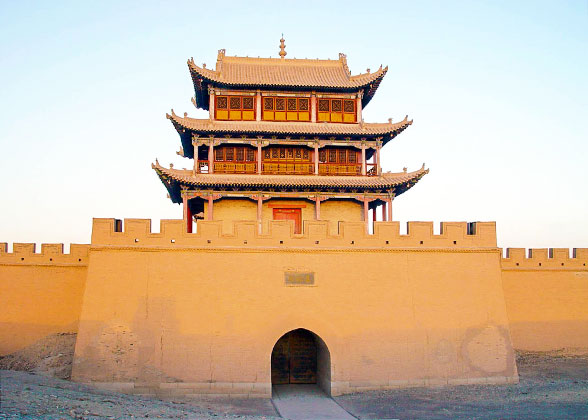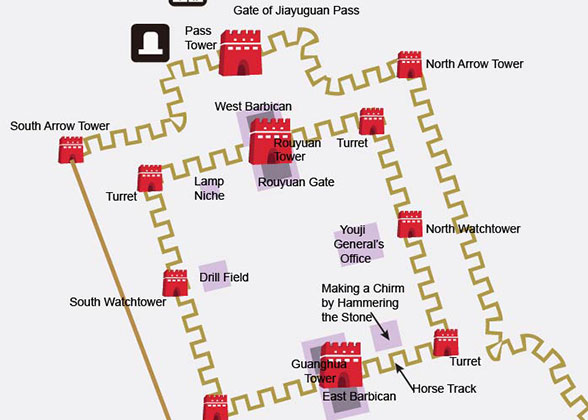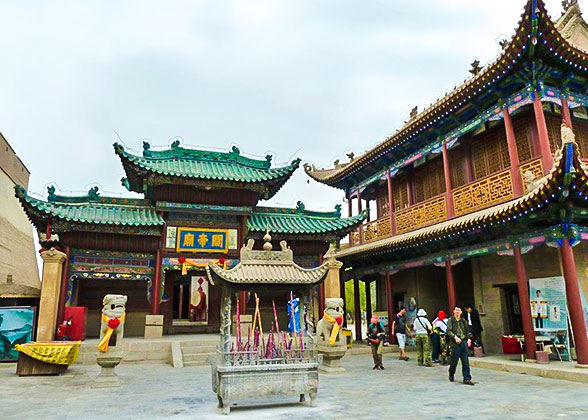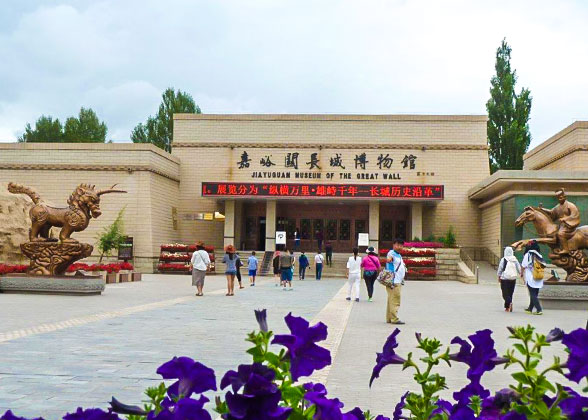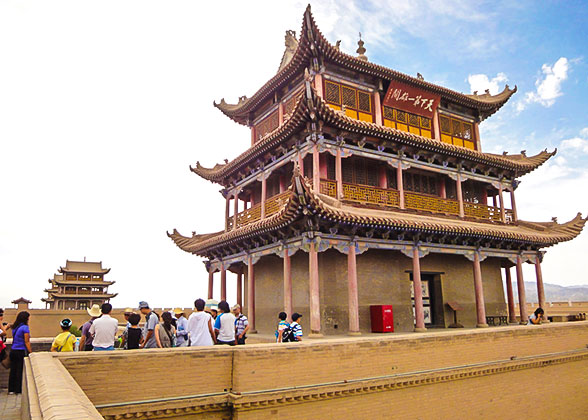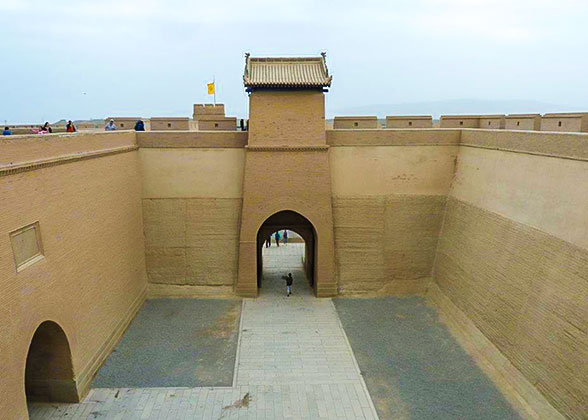Jiayuguan Great Wall
|
|
Basic Facts of Jiayuguan
![]() Jiayu Pass was built in the Ming Dynasty (1368 – 1644) under the supervision of Feng Sheng, a founding general of the Ming Dynasty. When first completed, there were only ramparts surrounding the barracks. After 168 years of enhancements, the pass assumed its present appearance.
Jiayu Pass was built in the Ming Dynasty (1368 – 1644) under the supervision of Feng Sheng, a founding general of the Ming Dynasty. When first completed, there were only ramparts surrounding the barracks. After 168 years of enhancements, the pass assumed its present appearance.
![]() Covering an area of 33,529 square meters (40,100 square yards), Jiayuguan Pass of Great Wall has a complex and integrated defensive system: an inner city, the central area with many buildings, an outer city, and finally a moat. You can also find common military facilities such as arrow towers, turrets, and cannons along the wall.
Covering an area of 33,529 square meters (40,100 square yards), Jiayuguan Pass of Great Wall has a complex and integrated defensive system: an inner city, the central area with many buildings, an outer city, and finally a moat. You can also find common military facilities such as arrow towers, turrets, and cannons along the wall.
![]() Jiayu Pass was also a vital traffic fort along the Silk Road, the world's oldest trading route, connecting China, Central Asia and Europe.
Jiayu Pass was also a vital traffic fort along the Silk Road, the world's oldest trading route, connecting China, Central Asia and Europe.
Inner City
Encompassing an area of 25,000 square meters (six acres), the inner city is enclosed by a city wall which runs for 640 meters (700 yards) and reaches a height of 11 meters (36 feet). It has two gates in the east and west respectively, known as the Guanghua and Rouyuan. Each gate is protected by a smaller guard tower and a barbican in front, forming another defensive screen for the inner city.
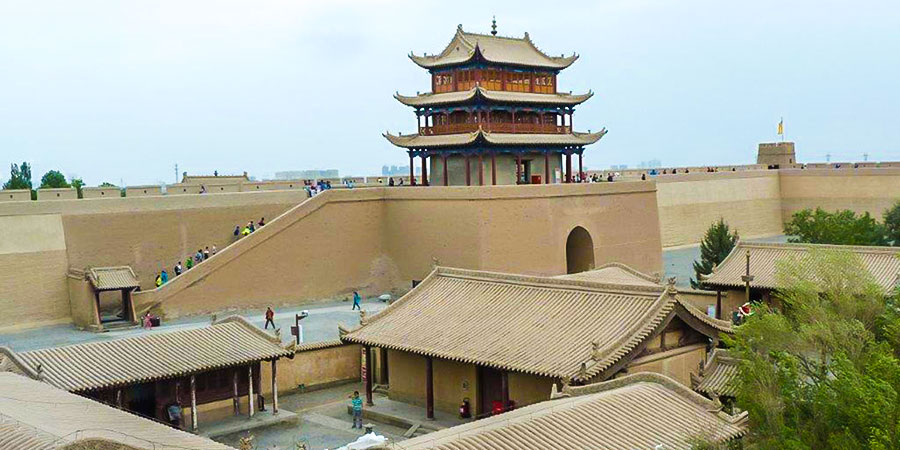 |
| Inner City of Jiayuguan |
Outer City
Outside the inner city, there is another barrier forming the first defensive line of the pass – the outer city. As the major defensive point, the west wall of the outer city was built up with bricks, making it very solid. There is a three-story tower with a plaque that reads 'Tian Xia Di Yi Xiong Guan' (the First and Greatest Pass under Heaven) to state the military importance and strength of Jiayu Pass.
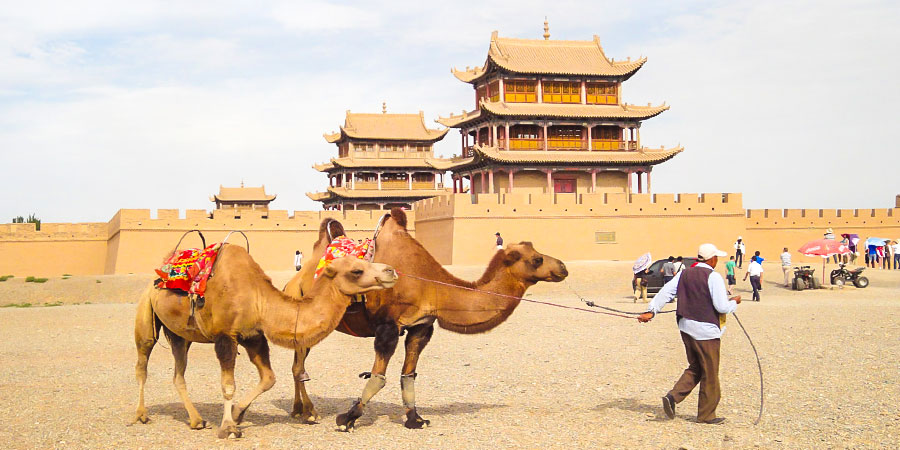 |
| Outer City of Jiayuguan |
Along with the vast Gobi desert and solid military constructions, the old buildings of the pass are also worth taking in:
![]() Youji General's Office – It was the location in the inner city where the generals guarding Jiayu Pass dealt with military affairs. The meeting hall in the front yard reproduces the scene of generals planning military strategy, while you can have a rough idea of the living situation of the generals' families in the back yard.
Youji General's Office – It was the location in the inner city where the generals guarding Jiayu Pass dealt with military affairs. The meeting hall in the front yard reproduces the scene of generals planning military strategy, while you can have a rough idea of the living situation of the generals' families in the back yard.
![]() Wenchang Hall – It is a two-story pavilion in front of the inner city. It follows the same design style as the gate towers and is decorated with lattice doors and windows. The pavilion was once a great meeting place for literati to read, paint and compose poetry until the late Qing Dynasty (1644 – 1911). After that, it became the work place of civil officials.
Wenchang Hall – It is a two-story pavilion in front of the inner city. It follows the same design style as the gate towers and is decorated with lattice doors and windows. The pavilion was once a great meeting place for literati to read, paint and compose poetry until the late Qing Dynasty (1644 – 1911). After that, it became the work place of civil officials.
![]() Temple of Guan Yu – Outside the east barbican, it is a place where people pay homage to Guan Yu, an invincible general of the Kingdom of Shu (221 – 263).
Temple of Guan Yu – Outside the east barbican, it is a place where people pay homage to Guan Yu, an invincible general of the Kingdom of Shu (221 – 263).
![]() Opera Tower – It is located near the east barbican outside the inner city. In old times, soldiers, local residents and traveling merchants often relaxed by watching operas there. Chinese cultural symbols such as red pillars, upswept cornices, exquisitely carved beams, and murals of the Eight Immortals can be found there.
Opera Tower – It is located near the east barbican outside the inner city. In old times, soldiers, local residents and traveling merchants often relaxed by watching operas there. Chinese cultural symbols such as red pillars, upswept cornices, exquisitely carved beams, and murals of the Eight Immortals can be found there.
![]() Jiayuguan Great Wall Museum – It is at the east gate of the scenic area and looks like a giant white beacon tower. Here, you can better understand the architectural history of this huge defense line and have a look at the old weapons and paintings of the Great Wall.
Jiayuguan Great Wall Museum – It is at the east gate of the scenic area and looks like a giant white beacon tower. Here, you can better understand the architectural history of this huge defense line and have a look at the old weapons and paintings of the Great Wall.
|
|
Travel Tips
![]() It takes about two hours to finish the whole trip. Visitors who prefer a less strenuous experience can pay CNY 10 to rent a bike at the gate of the scenic area.
It takes about two hours to finish the whole trip. Visitors who prefer a less strenuous experience can pay CNY 10 to rent a bike at the gate of the scenic area.
![]() The ramparts and gate towers are the best viewing points to admire the surrounding scenes. Standing on the tower, it feels like you are alone in the vast desert with snow-capped Qilian Mountain in the distance. It's a perfect frontier experience.
The ramparts and gate towers are the best viewing points to admire the surrounding scenes. Standing on the tower, it feels like you are alone in the vast desert with snow-capped Qilian Mountain in the distance. It's a perfect frontier experience.
![]() The best time to take pictures is at sunset. The old pass looks magnificent with the scarlet sunlight slanting across the land.
The best time to take pictures is at sunset. The old pass looks magnificent with the scarlet sunlight slanting across the land.
![]() You can also get a bird-eye view of the pass by paraglider. Each glider can only take one person at a time. The price is CNY 300/per person.
You can also get a bird-eye view of the pass by paraglider. Each glider can only take one person at a time. The price is CNY 300/per person.
| Admission Fee | May to October: CNY 110 |
| November to April: CNY 90 | |
| Sightseeing car inside the pass | CNY 10 |
| Opening Hours | May to October: 8:30 – 20:00 |
| November to April: 8:30 – 18:00 | |
| Recommended Time to Visit | May to October |
![]() The ticket also includes the entrances to the First Fire Tower - the westernmost pier of the Great Wall, eight kilometers (five miles) south of Jiayu Pass, and the Overhanging Great Wall – a section built on steep and bare mountain, eight kilometers (five miles) north of the pass. There is no shuttle bus among the three spots. You are advised to charter a minibus to travel between them.
The ticket also includes the entrances to the First Fire Tower - the westernmost pier of the Great Wall, eight kilometers (five miles) south of Jiayu Pass, and the Overhanging Great Wall – a section built on steep and bare mountain, eight kilometers (five miles) north of the pass. There is no shuttle bus among the three spots. You are advised to charter a minibus to travel between them.
|
|
How to Get to the Pass from Jiayuguan City
The pass is six kilometers (four miles) west of the city proper. It won't take much time to get there from the city.![]() By bus
By bus
Take bus no.4 or no.6 to the terminal station, and walk to the ticket office. The two bus lines both operate from 7:00 to 20:00 and costs CNY 1.![]() By minibus
By minibus
If you want to visit the First Fire Tower and the Overhanging Great Wall all together, it is recommended to charter a minibus from the city. It would cost CNY 150~180/per bus.
![]() Further Reading:
Further Reading:
Legends of Jiayuguan Pass
6 Best Places to See Great Wall of China

